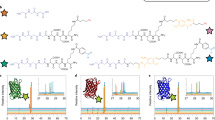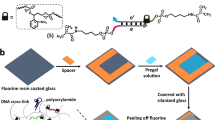Abstract
Polyacrylamide is a widely used material in cell mechanobiology research. Here, we validate and optimize a method to activate polyacrylamide substrates for protein patterning, resulting in a system with precise and independent control over the geometric and mechanical factors that cells perceive. Acrylic acid incorporated into the hydrogel provides functional sites for activation with N-hydroxysuccinimide, which in turn forms covalent bonds with proteins printed in microscale patterns. To validate and optimize substrate fabrication, we demonstrate that acrylic acid incorporates into the polymer, that is has no effect on Young’s modulus at up to 0.4 wt%, and that increasing concentrations of acrylic acid result in substrates with increasing amounts of protein bound to them. Finally, we demonstrate that cells attach and spread to substrates with protein patterned with electrohydrodynamic jet (e-jet) printing. The method represents an improvement over the most-widely used method to chemically activate polyacrylamide with sulfo-SANPAH. With further refinement, truly independent control over ligand density and stiffness is possible. These substrates are powerful platforms for exploring the interacting influence of substrate stiffness and ligand density on cell behavior.







Similar content being viewed by others
Abbreviations
- AAm:
-
Acrylamide
- ANOVA:
-
Analysis of variance
- APS:
-
Ammonium persulfate
- bis:
-
N,N′-methylenebisacrylamide
- BSA:
-
Bovine serum albumin
- ECM:
-
Extracellular matrix
- EDC:
-
1-Ethyl-3-(3-dimethylaminopropyl) carbodiimide hydrochloride
- e-jet:
-
Electrohydrodynamic jet printing
- HEPES:
-
4-(2-Hydroxyehtyl)-1-piperazineethanesulfonic acid
- HBSS:
-
HEPES-buffered saline solution
- MES:
-
2-(N-morpholino)ethane sulfonic acid
- microBCA:
-
Micro bicinchoninic acid
- NHS:
-
N-hydroxysuccinimide
- PBS:
-
Phosphate-buffered saline
- sulfo-SANPAH:
-
N-sulfosuccinimidyl-6-(4′-azino-2′-nitrophenylamino) hexanoate
- TEMED:
-
N,N,N′,N′-tetramethylethylenediamine
References
Aratyn-Schaus, Y., P. W. Oakes, J. Stricker, S. P. Winter, and M. L. Gardel. Preparation of compliant matrices for quantifying cellular contraction. J. Vis. Exp. 46, 2010. doi:10.3791/2173.
Beningo, K. A., and Y.-L. Wang. Fc-receptor mediated phagocytosis is regulated by mechanical properties of the target. J. Cell Sci. 115:849–856, 2002.
Boudou, T., J. Ohayon, C. Picart, and P. Tracqui. An extended relationship for the characterization of Young’s modulus and Poisson’s ratio of tunable polyacrylamide gels. Biorheology 43:6, 2006.
Califano, J. P., and C. A. Reinhart-King. A balance of substrate mechanics and matrix chemistry regulates endothelial cell network assembly. Cell. Mol. Bioeng. 1:2–3, 2008.
Choi, H. K., J. U. Park, O. O. Park, P. M. Ferreira, J. G. Georgiadis, and J. A. Rogers. Scaling laws for jet pulsations associated with high-resolution electrohydrodynamic printing. Appl. Phys. Lett. 92:12, 2008.
Damljanovic, V., B. C. Lagerholm, and K. Jacobson. Bulk and micropatterned conjugation of extracellular matrix proteins to characterized polyacrylamide substrates for cell mechanotransduction assays. Biotechniques 39:6, 2005.
Diduch, D. R., M. R. Coe, C. Joyner, M. E. Owen, and G. Balian. 2 cell-lines from bone-marrow that differ in terms of collagen-synthesis, osteogenic characteristics, and matrix mineralization. J. Bone Joint Surg. Am. 75A:92–105, 1993.
Engler, A. J., L. Bacakova, C. Newman, A. Hategan, M. Griffin, and D. Discher. Substrate compliance versus ligand density in cell on gel responses. Biophys. J. 86:1, 2004.
Engler, A. J., S. Sen, H. L. Sweeney, and D. E. Discher. Matrix elasticity directs stem cell lineage specification. Cell 126:4, 2006.
Gaudet, C., W. A. Marganski, S. Kim, C. T. Brown, V. Gunderia, M. Dembo, and J. Y. Wong. Influence of type I collagen surface density on fibroblast spreading, motility, and contractility. Biophys. J. 85:5, 2003.
Grabarek, Z., and J. Gergely. Zero-length crosslinking procedure with the use of active esters. Anal. Biochem. 185:1, 1990.
Gray, D. S., J. Tien, and C. S. Chen. Repositioning of cells by mechanotaxis on surfaces with micropatterned Young’s modulus. J. Biomed. Mater. Res. A 66A:3, 2003.
Grevesse, T., M. Versaevel, G. Circelli, S. Desprez, and S. Gabriele. A simple route to functionalize polyacrylamide hydrogels for the independent tuning of mechanotransduction cues. Lab Chip 13:777–780, 2013.
Hermanson, G. T. Bioconjugate Techniques (2nd ed.). Amsterdam: Academic Press, pp. 215–223, 2008.
Hermanson, G. T. Bioconjugate Techniques (2nd ed.). Amsterdam: Academic Press, pp. 562–568, 2008.
Kandow, C. E., P. C. Georges, P. A. Janmey, and K. A. Beningo. Polyacrylamide hydrogels for cell mechanics: steps toward optimization and alternative uses. Methods Cell Biol. 83:29–46, 2007.
Khatiwala, C. B., S. R. Peyton, and A. J. Putnam. Intrinsic mechanical properties of the extracellular matrix affect the behavior of pre-osteoblastic MC3T3-E1 cells. Am. J. Physiol. Cell Physiol. 290:6, 2006.
Kilian, K. A., B. Bugarija, B. T. Lahn, and M. Mrksich. Geometric cues for directing the differentiation of mesenchymal stem cells. Proc. Natl. Acad. Sci. 107:11, 2010.
Li, Y., Z. Hu, and L. Chunfang. New method for measuring Poisson’s ratio in polymer gels. J. Appl. Polym. Sci. 50:6, 1993.
Liu, V. A., and S. N. Bhatia. Three-dimensional photopatterning of hydrogels containing living cells. Biomed. Microdevices 4:4, 2002.
McBeath, R., D. M. Pirone, C. M. Nelson, K. Bhadriraju, and C. S. Chen. Cell shape, cytoskeletal tension, and RhoA regulate stem cell lineage commitment. Dev. Cell 6(4):483–495, 2004.
Menter, P. Acrylamide Polymerization—A Practical Approach. Hercules: Bio-Rad Laboratories, 2000.
Nakajima, N., and Y. Ikada. Mechanism of amide formation by carbodiimide for bioconjugation in aqueous media. Bioconjug. Chem. 6:1, 1995.
Park, J. U., M. Hardy, S. J. Kang, K. Barton, K. Adair, D. K. Mukhopadhyay, C. Y. Lee, M. S. Strano, A. G. Alleyne, J. G. Georgiadis, P. M. Ferreira, and J. A. Rogers. High-resolution electrohydrodynamic jet printing. Nat. Mater. 6:10, 2007.
Paszek, M. J., N. Zahir, K. R. Johnson, J. N. Lakins, G. I. Rozenberg, A. Gefen, C. A. Reinhart-King, S. S. Margulies, M. Dembo, D. Boettiger, D. A. Hammer, and V. M. Weaver. Tensional homeostasis and the malignant phenotype. Cancer Cell 8:3, 2005.
Pelham, R. J., and Y. L. Wang. Cell locomotion and focal adhesions are regulated by substrate flexibility. Proc. Natl. Acad. Sci. USA 94:25, 1997.
Poellmann, M. J., K. L. Barton, S. Mishra, and A. J. Wagoner Johnson. Patterned hydrogel substrates for cell culture with electrohydrodynamic jet printing. Macromol. Biosci. 11(9):1164–1168, 2011.
Poellmann, M. J., P. A. Harrell, W. P. King, and A. J. Wagoner Johnson. Geometric microenvironment directs cell morphology on topographically patterned hydrogel substrates. Acta Biomater. 6(9):3514–3523, 2010.
Saha, K., A. J. Keung, E. F. Irwin, Y. Li, L. Little, D. V. Schaffer, and K. E. Healy. Substrate modulus directs neural stem cell behavior. Biophys. J. 95:9, 2008.
Sano, S., K. Kato, and Y. Ikada. Introduction of functional groups onto the surface of polyethylene for protein immobilization. Biomaterials 14:11, 1993.
Trappmann, B., J. E. Gautrot, J. T. Connelly, D. G. T. Strange, Y. Li, M. L. Oyen, M. A. Cohen Stuart, H. Boehm, B. Li, V. Vogel, J. P. Spatz, F. M. Watt, and W. T. S. Huck. Extracellular-matrix tethering regulates stem-cell fate. Nat. Mater. 11(7):642–649, 2012.
Tse, J. R., and A. J. Engler. Preparation of hydrogel substrates with tunable mechanical properties. Curr. Protoc. Cell Biol. 47:10, 2010.
Wang, D., K. Christensen, K. Chawla, G. Xiao, P. H. Krebsbach, and R. T. Franceschi. Isolation and characterization of MC3T3-E1 preosteoblast subclones with distinct in vitro and in vivo differentiation/mineralization potential. J. Bone Miner. Res. 14:6, 1999.
Wang, Y. L., and R. J. Pelham. Preparation of a flexible, porous, polyacrylamide substrate for mechanical studies of cultured cells. Methods Enzymol. 298:489–496, 1998.
Winer, J. P., P. A. Janmey, M. E. McCormick, and M. Funaki. Bone marrow-derived human mesenchymal stem cells become quiescent on soft substrates but remain responsive to chemical or mechanical stimuli. Tissue Eng. Part A 15:1, 2009.
Wong, J. Y., A. Velasco, P. Rajagopalan, and Q. Pham. Directed movement of vascular smooth muscle cells on gradient-compliant hydrogels. Langmuir 19(5):1908–1913, 2003.
Yeung, T., P. C. Georges, L. A. Flanagan, B. Marq, M. Ortiz, M. Funaki, N. Zahir, W. Ming, V. Weaver, and P. A. Janmey. Effects of substrate stiffness on cell morphology, cytoskeletal structure, and adhesion. Cell Motil. Cytoskelet. 60:1, 2005.
Acknowledgments
This manuscript is based on work supported by the Center for Nanoscale Chemical Electrical Mechanical Manufacturing Systems (Nano-CEMMS) at the University of Illinois, funded by the National Science Foundation under Grant DMI 0328162 and by NSF EAGER Grant CMMI 1264988. We acknowledge undergraduate researchers N. Patel, T. Perez, H. Friedman, and C. Frid for their assistance with some of the experiments.
Author information
Authors and Affiliations
Corresponding author
Additional information
Associate Editor Michael R. King oversaw the review of this article.
Electronic supplementary material
Below is the link to the electronic supplementary material.
Rights and permissions
About this article
Cite this article
Poellmann, M.J., Wagoner Johnson, A.J. Characterizing and Patterning Polyacrylamide Substrates Functionalized with N-Hydroxysuccinimide. Cel. Mol. Bioeng. 6, 299–309 (2013). https://doi.org/10.1007/s12195-013-0288-5
Received:
Accepted:
Published:
Issue Date:
DOI: https://doi.org/10.1007/s12195-013-0288-5




